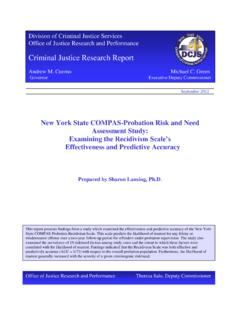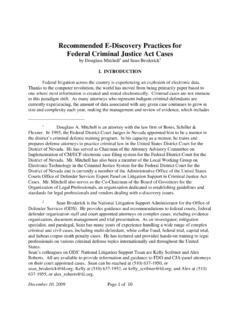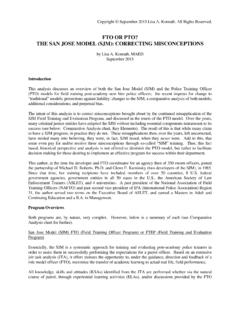Transcription of Implementing Organizational Change in Criminal Justice
1 Implementing Organizational Change in Criminal Justice : Some Lessons from Jail Classification Systems Tim Brennan, PhD Research Director, Northpointe Institute for Public Management & Research Associate Psychology Department University of Colorado, Boulder Northpointe Evolving Practice Through Scientific Innovation 2 Abstract This paper examines the underlying processes involved in Implementing complex Change in Criminal Justice . Such changes may include the implementation of new policies, procedures, information technology, or new programs. A large scale technical assistance program to help jails implement objective classification provided a series of long term case studies of the implementation process. A four-stage model of the implementation process developed during this project is described. This aimed to help jail managers and other Criminal Justice leaders conceptualize the process of implementation and it's sub-components.
2 Nineteen specific factors are described which critically influence the success of these implementation efforts. Key Words: Implementation models, Change management, Objective classification, Jail classification, Change strategies Northpointe Evolving Practice Through Scientific Innovation 3 Table of Contents Abstract .. 2 Introduction .. 4 Background of Objective Jail Classification Systems .. 5 Classification within the Jail .. 7 The Difficulty of Implementing Change in Criminal Justice .. 9 The Importance of Implementation Skills .. 10 A Sequential Model for the Implementation Process .. 11 Phase 1: Pre-Implementation .. 12 Phase 2: Design: Preliminary Testing, Validation, and Evaluation .. 15 Phase 3: Implementation (Going Live!) .. 17 Phase 4: Post-Implementation .. 19 Identifying Key Factors and Critical Problems for Successful Implementation.. 21 Factors Related to the "Content" of the Innovation .. 22 Factors within the Organizational Context .. 23 Factors Related to the Implementation Process.
3 26 Factors Related to the Agency s External Environment .. 28 Bibliography .. 31 Northpointe Evolving Practice Through Scientific Innovation 4 Introduction This paper examines the processes underlying the implementation of complex procedural or policy Change in Criminal Justice agencies. For the past two decades rapid Change , as opposed to procedural stability, has been the rule rather than the exception in Criminal Justice agencies. During this time we have witnessed profound changes in the philosophy of corrections, in sentencing models, in program designs, and in the introduction of information technologies. Criminal Justice managers face an intense challenge to develop skills in managing the implementation of new policies, programs and procedures. This paper uses the introduction of new objective classification procedures into jails as a basis to examine implementation strategies.
4 In the area of classification and risk assessment Criminal Justice agencies have faced several sources of pressure to Change or update their procedures. First, new developments in risk assessment and classification methods have been a major source of pressure to Second, new legislation or litigation has forced many agencies to upgrade their assessment and classification Litigation by prisoners and their advocates generally focuses on the weaknesses, inconsistency, or unfairness of current classification methods. Developments in information technology have also created a need for upgraded classification procedures. A first goal of this paper is to present a systematic model of implementation based on a large number of jail case studies conducted over a 10-year period. A second goal is to clarify the major practical lessons regarding success or failure of these implementation efforts. The case studies were part of a major national project in which new objective classification systems were being implemented in jails.
5 The project has been supported by the National Institute of Corrections (NIC) to help jails implement objective classification Over the history of this project NIC has provided regular management training seminars and ongoing technical assistance to over 150 jails. The aim is not to provide detailed descriptions of case studies, but to clarify more general lessons learned from these jail projects and to describe a generalized model of implementation that integrates the findings from these case studies with the fairly sparse literature on Criminal Justice implementation. This generalized model may provide jail administrators and other Criminal Justice managers with Northpointe Evolving Practice Through Scientific Innovation 5 an understanding of the sequential phases, tasks, and challenges when managing complex Change . The model aims to clarify the many management actions, tasks, and staff roles needed at key phases of implementation.
6 The development of this general model of implementation was influenced both by the field experiences in these jails and by several prior models of strategic Change : the strategic approach of Pettigrew et al.; 5 Walton's process framework;6 the work of Harris and Smith7 and Ellickson and Petersilia8 in Criminal Justice implementation; and Bushe and Shani (1991) in clarifying "learning capacity" of an organization. Several key questions emerged from these jail case studies. Each question was critical to success as each jail attempted to implement the new classification procedures. 1. What key skills are needed, and at what stages, by jail managers? 2. What are the relevant roles of leaders, Change agents, implementation teams, and other personnel in managing Change ? 3. What explains the significant variation between jails given that a highly similar implementation task, with similar classification technologies was being addressed by each jail?
7 Why did the speed and integrity of implementation vary so widely when the same issue was addressed at each jail? 4. Can a general model of implementation be used across agencies, and when different projects are implemented, or must each agency adopt a unique strategy? Background of Objective Jail Classification Systems The history of inmate classification in the United States closely parallels the evolution of the nation's correctional philosophy. Before 1870, when corrections focused on retribution and punishment, classification was based primarily on type of offense. Inmates were classified for the purpose of determining the "appropriate" punishment. There was no need to extend the process further because all inmates were housed in comparable settings and occupied their time in a similar manner. In the latter part of the nineteenth century, however, corrections changed direction: Reform and rehabilitation were introduced as important goals.
8 As these goals gained prominence and acceptance, classification began to ground Northpointe Evolving Practice Through Scientific Innovation 6 itself in clinical diagnostic categories that emphasized offenders "personal pathologies." Inmates, because they had been arrested and convicted, were assumed to be deficient in personal growth and survival skills. The task of classification was to identify such deficiencies so that they could be corrected. Use of this medical model of classification proliferated during much of the twentieth century as the psychological and sociological causes of crime were explored and as methods for assessing offenders grew more sophisticated. This trend continued into the early 1970s. At that time it began to lose favor because of public frustration with rising crime rates, gratuitous violence, and perceived failure of treatment-oriented programs. Today, corrections in many jurisdictions is based increasingly on a retributive (punishment) or "just desserts" philosophy of handling offenders.
9 Previous assumptions about the efficacy of rehabilitation have been challenged. Litigation has also increased in regard to inappropriate use of criteria for determining how inmates are housed, and when and whether they are permitted to participate in correctional programs. These developments, along with the well-publicized national jail crowding crisis, have affected traditional classification strategies governing the management of inmates. Correctional classification systems have been moving from so-called "subjective" models to "objective" systems. Subjective models tend to rely on informal criteria, which often lead to inconsistency and error in staff members decision making. Conversely, objective systems depend on a narrow set of well-defined legal criteria ( , severity of current offense, prior arrests) and personal characteristics such as age and marital status. These items are weighted and assigned differential values (points) on a well-defined instrument, which then is used to assess an inmate's level of risk or program needs.
10 Objective systems place greater emphasis on fairness, consistency, and openness in the decision-making process. In 1973 the National Advisory Committee on Criminal Justice Standards and Goals outlined standards for inmate classification. More recently, as a result of the increasing emphasis on classification as a management tool and the growing pressure to improve classification, considerable attention has been focused on the process of classification. Many individuals and organizations have provided guidance in structuring effective procedures. Among the most widely accepted guidelines are the 14 principles formulated by Solomon (1980) and subsequently adopted by the National Institute of Corrections (NIC): Northpointe Evolving Practice Through Scientific Innovation 7 1. There must be a clear definition of goals and objectives of the total correctional system. 2. There must be detailed written procedures and policies governing the classification process.












